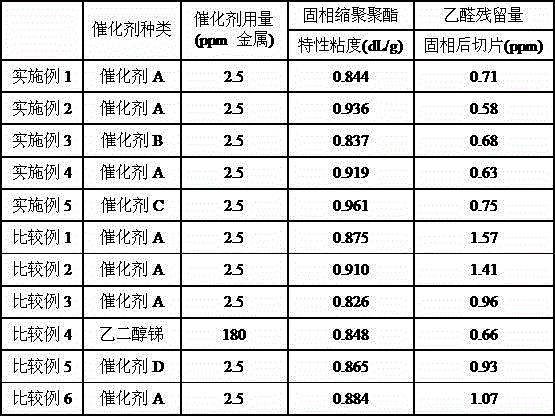Production method of low acetaldehyde titanium system polyester
A technology of titanium-based polyester and a production method is applied in the production field of low-acetaldehyde titanium-based polyester, and can solve the problems of high residual acetaldehyde and slow solid-phase polymerization of polyester.
- Summary
- Abstract
- Description
- Claims
- Application Information
AI Technical Summary
Problems solved by technology
Method used
Image
Examples
Embodiment 1
[0038] Preparation of Catalyst A
[0039] Add 12.4 grams (0.2 moles) of ethylene glycol into a reactor equipped with a stirrer, a condenser and a thermometer, slowly drop 28.4 grams (0.1 moles) of tetraisopropyl titanate into the reactor, and precipitate a white precipitate. After reacting at 70°C for 2 hours, the product was centrifuged, and the residue was washed with distilled water three times, and the product was vacuum-dried at 70°C to obtain a white powder.
[0040] Place the dried white powdery substance in a reactor with a stirrer, a condenser and a thermometer, add 50 grams of ethylene glycol, 32 grams of 25% aqueous sodium hydroxide solution (0.2 mol), 18 grams of lactic acid (0.2 moles), 28 grams (0.2 moles) of trimethyl phosphate, and 73.2 grams (0.4 moles) of zinc acetate were reacted for 2 hours at a reaction temperature of 150° C. to obtain a nearly colorless homogeneous liquid, which was Catalyst A.
[0041] Preparation of polyester
[0042] 600 grams of ter...
Embodiment 2
[0048] Preparation of polyester
[0049] 600 grams of terephthalic acid, 316 grams of ethylene glycol and catalyst A (based on the amount of polyester produced, the weight of titanium atoms is 2.5ppm), mixed to form a slurry, added to the polymerization tank for esterification , The esterification temperature is 230-255°C, the pressure is 0.25MPa, and the water generated by the reaction is discharged through the rectification device. Return to normal pressure after the esterification, add potassium acetate 6 × 10 -3 g (6×10 -5 mol), zinc acetate 1.6×10 -2 g (8×10 -5 mol), vacuumize and decompress until the system pressure is lower than 130Pa, and at the same time, the reaction temperature gradually rises to 280°C. When the system reaction reaches 150min, the reaction is stopped, and the reaction product is continuously extruded from the bottom of the polymerization kettle in a strip shape, cooled and cut. grain.
[0050] Solid State Polymerization of Polyester
[0051] P...
Embodiment 3
[0055] Preparation of Catalyst B
[0056] Add 12.4 grams (0.2 moles) of ethylene glycol into a reactor equipped with a stirrer, a condenser and a thermometer, slowly drop 28.4 grams (0.1 moles) of tetraisopropyl titanate into the reactor, and precipitate a white precipitate. After reacting at 70°C for 2 hours, the product was centrifuged, and the residue was washed with distilled water three times, and the product was vacuum-dried at 70°C to obtain a white powder.
[0057] Place the dried white powdery substance in a reactor with a stirrer, a condenser and a thermometer, add 50 grams of ethylene glycol, 32 grams of 25% aqueous sodium hydroxide solution (0.2 moles), citric acid monohydrate 63 g (0.3 mole), 28 g (0.2 mole) of trimethyl phosphate, and 42.6 g (0.3 mole) of magnesium acetate were reacted at a reaction temperature of 150° C. for 2 hours to obtain a nearly colorless homogeneous liquid, which was catalyst B.
[0058] Preparation of polyester
[0059] 600 grams of te...
PUM
 Login to View More
Login to View More Abstract
Description
Claims
Application Information
 Login to View More
Login to View More - R&D
- Intellectual Property
- Life Sciences
- Materials
- Tech Scout
- Unparalleled Data Quality
- Higher Quality Content
- 60% Fewer Hallucinations
Browse by: Latest US Patents, China's latest patents, Technical Efficacy Thesaurus, Application Domain, Technology Topic, Popular Technical Reports.
© 2025 PatSnap. All rights reserved.Legal|Privacy policy|Modern Slavery Act Transparency Statement|Sitemap|About US| Contact US: help@patsnap.com

